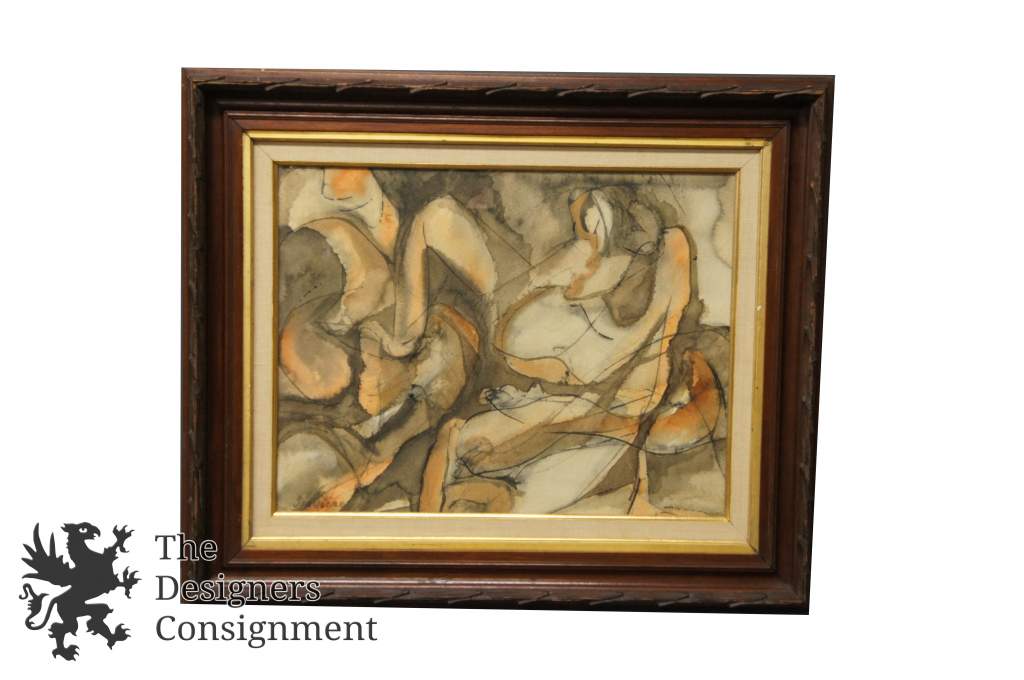
Shipping:
Free Shipping Included
Delivery:
Estimated 2-15 Business Days
Payments:
Credit Card, Check, Cash, PayPal, Apple Pay, Venmo
Returns:
30 Days 100% Money Back Guarantee, Buyer Pays Return Shipping
Description
David Alfaro Siqueiros
(1896-1974)
#18347MS
A beautiful signed abstract watercolor on paper. Framed in Mahogany with cloth matte. Signed on the lower left.
David Alfaro Siqueiros was born in 1896 in Chihuahua City, Mexico. He was to become one of Mexico's most original and distinguished painters. His art is one of violent social protest expressed in dynamic, swirling brushstrokes, dramatic contrasts of light and shade, brilliant colors and heroic themes, all visible in the available work Atrapado.
From an early age he was involved in politics and art -- two forces that stayed with him throughout his life. By the age of 15 he was already deeply involved in his artistic studies as well as political activism. In 1911 at San Carlos Academy, he led a student strike that was designed by Siqueiros to force changes in the school's teaching methods. Lasting six months it ended in complete victory for the students.
Perhaps it was Siqueiros' early victory that inspired him to be politically active throughout his life. There have been few, if any, individuals associated with the arts that have been involved in direct political action more than Siqueiros. Following his first taste of politics, Siqueiros surrounded himself with constant political upheaval and revolutionary activity for the rest of his life, all the while producing art.
Siqueiros was recognized early on as a talented artist, but his politics and his art shared equal ground throughout his life. His professional recognition did not prevent the government from taking action against him, and the Mexican government recognized his as a dangerous subversive from early in his art career. The high drama that filled his life resulted in a body of work that is a reflection of his social and political preoccupations.
Siqueiros was frequently imprisoned for his left wing political views. It was in jail that he created the majority of his easel works. Siqueiros traveled overseas extensively as a young man. He was involved with the Anarchists in Barcelona, spent time in France, and then in 1928 traveled to the young Soviet Union. While in France, Siqueiros came in contact with all the stimulating contemporary artistic movements of the early 20th century as well as works by the European Old Masters. Michelangelo's influence on Siqueiros can be seen in his works that contain powerful, foreshortened figures and bold perspective. In 1931, as a result of his politics and actions, Siqueiros was confined to Taxco, Mexico in a status of internal exile. However, his restricted movement in no way dampened his creative spirit, and while in Taxco he created over 100 paintings.
In 1932, Siqueiros was expelled from Mexico for political activity and arrived in the United States where he painted three murals. Siqueiros returned to Mexico when the political climate shifted and the left-wing President Lazaro Cardenas came to power in 1934. In 1936, at the outbreak of the Spanish Civil War, Siqueiros went to Spain and enlisted in the anti-fascist forces. He served three years in Spain, rising to the rank of lieutenant colonel and returned to Mexico following Franco's victory.
Siqueiros is best known for his mural painting. Muralism was embraced by Mexico's post-revolutionary government as a powerful way of advancing the social and political ideals of the Mexican revolution. Siqueiros, along with Diego Rivera and Jose Clemente Orozco were known as "los tres grandes" (the three great ones) of Mexican mural painting. Of these artists, Siqueiros may have been the most innovative. He conceived of his murals as dynamic rather than static images. His style of experimentation with the integration of traditional Mexican art and modern art was quite unique. Many of Siqueiros' murals deal with Mexican and Latin American history - they are reflections of an opposition to tyranny and his sympathy for workers and victims of oppression.
His revolutionary artwork paralleled the radical changes that were taking place in Mexico at the time. David Alfaro Siqueiros was very progressive in his use of modern industrial materials, equipment and techniques, such as the spray gun and synthetic paints. He was the first artist to use acrylics as a painting medium. He frequently used piroxiline, a substance related to gun cotton, which dries at amazing speed. It was through his experimentation that Siqueiros was able to give his works a three-dimensional quality.
Siqueiros produced masterpieces throughout his life, always pushing the limits of change and innovation. In 1974, at the age of 78, Siqueiros died in Cuernavaca, Mexico. Isaac Deutscher, Trotsky's biographer, poetically describes Siqueiros as a "Latin American buccaneer" - a man in whom "art, revolution and gangsterism are inseparable."
--Gretchen Van Camp
Latin American Art
Art Cellar Exchange
Biography from Askart.com
Condition
Good Vintage Condition - Some Damage to Frame
Dimensions
31.25" x 26.25" x 2"
Sans Frame - 22.375" x 17.125"
(L x W x H)